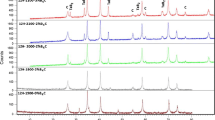The lattice parameter of TaC–TaB2 balk prepared by mechano-chemical and spark plasma sintering (SPS) was investigated by the Nelson–Riley method. In this study, TaC–B4C powder was milled for 3, 6, 9, 12 hours and sintered by spark plasma sintering. The lattice parameter and C/Ta ratio of TaC–TaB2 was calculated by the Nelson–Riley method and the Storms relation. In this research, TaC–B4C powder was reacted and produced TaC–TaB2 composite. Phase formation and powder morphology during milling and sintering were examined using different analysis techniques including XRD and FE-SEM. The lattice parameter of the powders was increased by milling time and sintering temperature.







Similar content being viewed by others
References
T. H. Squire and J. Marschall, “Material property requirements for analysis and design of UHTC components in hypersonic applications,” J. Eur. Ceram. Soc., 30(11), 2239 – 2251 (2010).
F. Monteverde, A. Bellosi, and L. Scatteia, “Processing and properties of ultra-high temperature ceramics for space applications,” Mater. Sci. Eng. A, 485(1), 415 – 421 (2008).
D.-H. Kwon, S.-H. Hong, and B.-K. Kim, “Fabrication ofultrafine TaC powders by mechano-chemical process,” Mater. Lett., 58(30), 3863 – 3867 (2004).
X. Zhang, G. E. Hilmas, and W. G. Fahrenholtz, “Densification and mechanical properties of TaC-based ceramics,” Mater. Sci. Eng. A, 501(1), 37 – 43 (2009).
G. Hagemann, H. Immich, T. V. Nguyen, and G. E. Dumnov, “Advanced rocket nozzles,” J. Propuls. Power, 14(5), 620 – 634 (1998).
R. G. Munro, “Material properties of titanium diboride,” J. Res. Natl. Inst. Stand. Technol., 105(5), 709 – 720 (2000).
W. G. Fahrenholtz, G. E. Hilmas, I. G. Talmy, and J. A. Zaykoski, “Refractory diborides of zirconium and hafnium,» J. Am. Ceram. Soc., 90(5), 1347 – 1364 (2007).
B. Mehdikhani, S. R. Bakhshi, “Synthesis and spark plasma sintering of TaC–TaB2 nanocomposites,” J. Optoelectron. Adv. Mater., 16(11 – 12), 1311 – 1316 (2014).
X. Zhang, G. E. Hilmas, W. G. Fahrenholtz, and D. M. Deason, “Hot pressing of tantalum carbide with and without sintering additives,” J. Am. Ceram. Soc., 90(2), 393 – 401 (2007).
Ye. F. Liu. L and Y. Zhou, “Microstructure and mechanical properties of spark plasma sintered TaC0.7 ceramics,” J. Am. Ceram. Soc., 93(10), 2945 – 2947 (2010).
R. Steinitz, “Mechanical properties of refractory carbide at high temperature,” In: Nuclear Applications of Nonfissionable Ceramics, Ed. by A. Boltax and J. H. handwerk, Am. Nucl. Society, Hinsdale, IL, 1966, pp. 75 – 100.
E. Rudy, D. P. Harmon, Figure 8956-system Ta-C. Phase Eguilibria Diagrams, Phase Diagrams for Ceramics, Vol. X. Boride, Carbides, and Nitrides, Ed. by A. E. Mchale, The American Ceramic Society, Westerville, OH, 1994.
E. K. Storms, “The Refractory Carbides”, in: Refractory Materials, ASeries of Monographs, Ed. by J. L. Margrave, Academic Press Inc., New York,1967, p. 94.
X. Zhang, G. E. Hilmas, W. G. Fahrenholtz, and D. M. Deason, “Hot pressing of tantalum carbide with and without sintering additives,” J. Am. Ceram. Soc., 90(2), 393 – 401 (2007).
X. Zhang, G. E. Hilmas, and W. G. Fahrenholtz, “Densification and mechanical properties of TaC-based ceramics,» Mater. Sci. Eng. A, 501(1), 37 – 43 (2009).
J. B. Nelson and D. Riley, “An experimental investigation of extrapolation methods in the derivation of accurate unit-cell dimensions of crystals,” Proc. Phys. Soc., 57(3), 160 (1945).
G. Williamson, and W. Hall, “X-ray line broadening from filed aluminium and wolfram,” Acta Metall., 1(1), 22 – 31 (1953).
C. Suryanarayana and M. G. Norton, x-ray Diffraction: A Practical Approach, Springer, New York and London (1998).
A. E. McHale, System B-Ta-C. Isothermal Section at 1750°C. Phase Equilibria Diagrams, Phase Diagrams for Ceramists, Westerville, OH, The American Ceramic Society, Vol. X. Borides, Carbides, and Nitrides (1994).
Acknowledgement
The authors are indebted to the Material Department in Malek-e-ashtar University of Technology, which supplied the raw materials for this research, and to the Building and Construction Department of Standard Research Institute for equipment support.
Author information
Authors and Affiliations
Corresponding author
Additional information
Translated from Novye Ogneupory, No. 9, pp. 50 – 55, September, 2016.
Rights and permissions
About this article
Cite this article
Mehdikhan, B., Borhani, G.H., Bakhshi, S.R. et al. Effect of Milling and Sintering Temperature of TaC–TaB2 Composite on Lattice Parameter and C/Ta Ratio. Refract Ind Ceram 57, 507–512 (2017). https://doi.org/10.1007/s11148-017-0013-3
Received:
Published:
Issue Date:
DOI: https://doi.org/10.1007/s11148-017-0013-3




